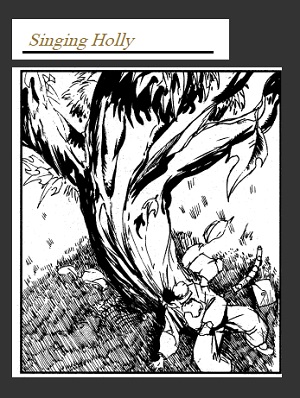Singing Holly (5e Creature)
Singing Holly[edit]
|
Large plant, unaligned Armor Class 13 (natural armor)
Saving Throws Str +6, Con +4, Wis +4 False Appearance. While the singing holly remains motionless, it is indistinguishable from a normal holly tree. Berries. If a creature eats a berry of the singing holly, the parasitic berry will lodge itself in the creature's stomach. A creature takes 3 (1d6) piercing damage daily at dawn until the berry is digested 3 (1d6) days later. Innate Spellcasting. The singing holly's innate spellcasting ability is Wisdom (spell save DC 12). The singing holly can innately cast the following spells, requiring no material components: At will: animal friendship, charm person ACTIONSMultiattack. The singing holly can make two branch attacks, and then uses its bleeding leaf swarm if it can. Branch. Melee Weapon Attack: +4 to hit, reach 10 ft., one target. Hit: 11 (2d6 + 4) bludgeoning damage, and if the target is a creature, it is grappled (escape DC 14). Sang-uine. Each creature within 50 feet of the tree must make a DC 12 Wisdom saving throw or be charmed by the singing holly until the end of its next turn. While charmed in this way, a creature spends its turn moving towards the tree. On a success, a creature is immune to this for 24 hours. Bleeding Leaf Swarm (Recharge 6). The singing holly launches needle-sharp leaves in a 15-foot line that is 5 feet wide. Each creature in that line must make a DC 12 Dexterity saving throw, taking 14 (4d6) piercing damage on a failed save, or half as much damage on a successful one.
|
A singing holly is a carnivorous plant that lures creatures to it with beautiful singing by its leaves and sometimes by the bass singing trunk. As the great Bard Johnny once sang: "Daddy sang bass, momma sang tenor..." Ecology. The tree procreates by allowing birds to eat its berries. The singing holly tree will not attack birds as long as they are feeding on its berries, or removing parasites from its leaves or trunk, unless it is starving. Once a bird eats the berries, one berry becomes parasitic, attaching itself to the stomach of the bird, the rest will pass through and die. The bird does not feel the berry attach itself, and eventually flies off and dies from a lack of blood, at which point the young singing holly sapling takes root in the carcass of the dead bird. If the new sapling is within 50 feet of another singing holly, the older singing holly will send out its leaves to attack the new sapling and kill it to protect its hunting ground. Habitat. Singing holly trees will grow in any environment where they can "hunt" creatures, especially small prey, but will not grow in extremely hot, dry or freezing environments. |
Back to Main Page → 5e Homebrew → Creatures

